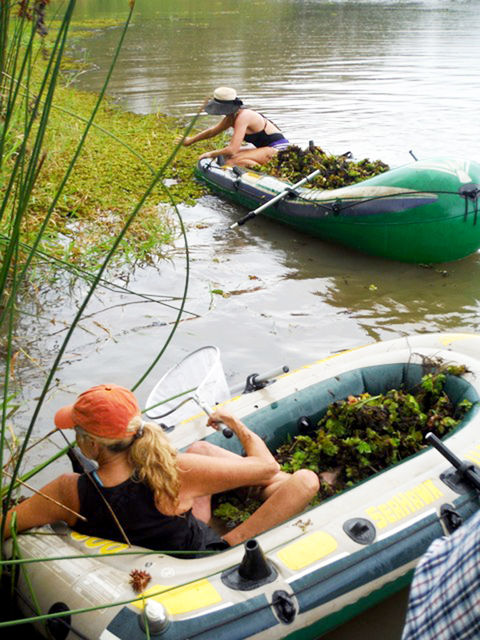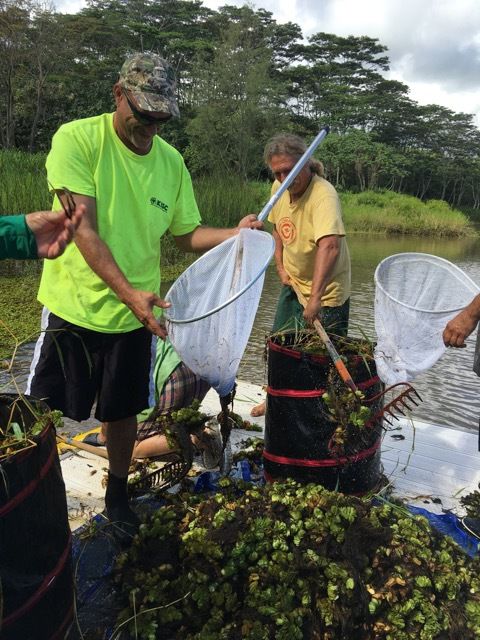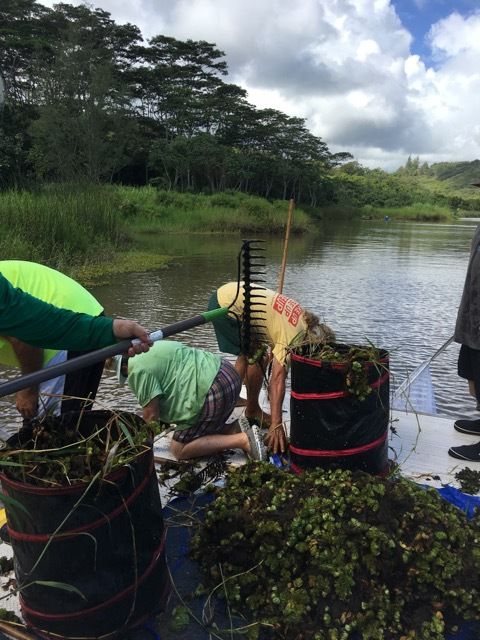KAHILI BEACH — After seven hours of tedious labor on a day in mid-August, about 20 volunteers plucked more than 200 pounds of invasive aquatic weeds from the Kilauea River. And they only removed about 5 percent of the total
KAHILI BEACH — After seven hours of tedious labor on a day in mid-August, about 20 volunteers plucked more than 200 pounds of invasive aquatic weeds from the Kilauea River.
And they only removed about 5 percent of the total salvinia growth that’s clogging the river’s banks.
“It’s along the banks, the entire length of the Kilauea River, on both sides,” said Pam Warren, who lives along the river and participated in the cleanup. “It’s obvious that many more volunteers, as well as county, state and federal agencies, are needed if we are to protect and maintain the Kilauea River.”
On Aug. 15, volunteers from Kilauea Neighborhood Association and the Rotary Club of Hanalei Bay joined forces with the Department of Agriculture and a team from Kauai Invasive Species Committee (KISC) to take on the invasive aquatic weed.
Warren said another cleanup is planned beginning at 7:30 a.m. Tuesday.
“It’s a very labor-intensive job and there was no way that we were going to solve it at one time,” Warren said. “But at least we worked out the kinks and we’re trying to rally community support again to get people to help us.”
Volunteers will meet at Kahili Beach, also known as Rock Quarries. Warren said it would be helpful if people bring inflatable rafts, kayaks and scoop nets with small weave.
“If we get another motorized boat, that would be lovely because you get so tired paddling back and forth,” Warren said.
Salvinia is on the DOA list of noxious weeds and is illegal to transport into Hawaii.
Salvinia is also found in Kealia Stream, according to Rachel Smith of KISC. However, the water flow in that stream is heavy enough that the weeds are periodically washed into the ocean.
“Salvinia can’t tolerate a high salinity, like ocean water,” Smith said. “So it dies when it gets out into the ocean.”
The Kilauea River, however, moves much more slowly and in a more meandering pattern, which means the plant has time to establish on its banks.
Salvinia grows in thick carpets on top of the water and sends out rhizomes under the water, Smith said. It spreads through plantlets, baby salvinia plants that are attached to the adult leaves.
The free-floating plant can block sunlight and nutrients from reaching the water below, creating the possibility for all sorts of environmental changes within the river — including change in fish behavior and algae growth, she explained.
“It’s composed of hundreds and hundreds of little, quarter-sized plants, so when there’s boat traffic, or anything that makes wave action, it will break off those quarter-sized chinks and they float down and start at a new location,” Warren said. “That’s how it’s spread.”
Smith suspects that salvinia, like most invasive species in Kauai, was originally introduced into the wild by escaping someone’s garden.
Once it’s in a waterway, it spreads quickly, Warren said.
“I first noticed it back in September, and since that time it has multiplied tenfold,” Warren said.
When it comes to cleaning out the salvinia from the Kilauea River, Warren said it’s a “multi-step process.”
Once the plants are removed, they’re piled up on private property where the landowner has given them permission to store the plants. From there, the salvinia goes to the Kilauea Ag Park for composting.
“Mark Freeman, with Heart and Soul Organics, has volunteered to collect it from there in his truck and take it to the ag park, making sure that it doesn’t cross any other streams,” Warren said.
Smith said that is am important piece of the puzzle.
“If you drop it into another stream when you’re crossing, it’ll take off there,” Smith said.
Those interested in helping clean up the Kilauea River can call Warren at 635-4743.




